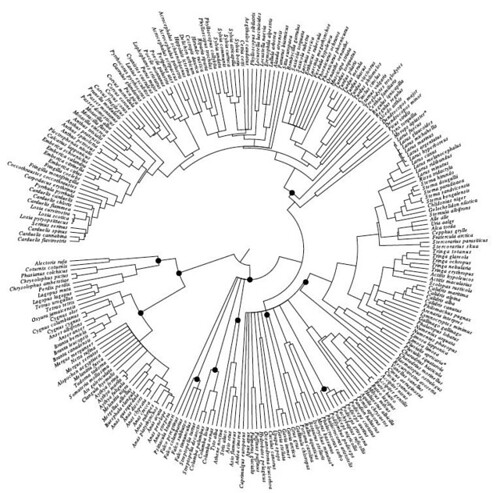tags: researchblogging.org, phylogeny, British birds, population decline, range contraction, Gavin H Thomas
A paper recently published by British scientist, Gavin Thomas, a population biologist at Imperial College London, finds that British bird species that currently are suffering population declines tend to be close relatives of each other. The reason is obvious: closely related species tend to share many traits, such as very precise habitat requirements, and what's bad for one species is also bad for another. However, the habits and needs of some species are poorly known, so this study suggests that conservationists could rely on genetic relatedness to predict future population declines and extinctions, even for relatively unknown species.
"Numbers of the common blackbird are currently not perceived as threatened at all, however it has several close relatives, including the song thrush, that are experiencing severe levels of population decline," observes Dr. Thomas, whose paper was just published in the Royal Society's Proceedings B journal. "This could mean that populations of blackbirds in the UK are at risk of declining in the future."
Using this same hypothesis, the European greenfinch, Carduelis chloris (below), might also be vulnerable to a population decline in the near future because its close relatives, linnets and bullfinches, are currently experiencing severe population declines.
European greenfinch, Carduelis chloris,
in the harsh autumn morning light,
eating the last berries of autumn in Helsinki, Finland.
But this hypthesis requires closer examination and rigorous testing before it can be relied upon as a predictive tool in conservation biology.
"This hasn't been tested on the ground, so we don't know at the moment whether the inferences we're making turn out to be true," Dr. Thomas cautioned.
Thomas's phylogeny, or family tree, is derived from mitochondrial sequence data for 248 species of British bird species that he retrieved from GenBank and analyzed using a relaxed clock Bayesian inference method (Figure 1);
Figure 1: A phylogeny of British birds. The phylogeny is the maximum credibility tree from the posterior distribution of trees. Nodes marked with a filled circle contain species that were constrained to be monophyletic a priori. Nodes with posterior probabilities less than 50% are collapsed to polytomies. Species marked with asterisks are species for which non-British congeners were used as surrogates. DOI: 10.1098/rspb.2008.0549 [larger view].
In addition to its predictive conservation potential, this phylogeny is also important because it documents evolutionary relationships between 93 percent of all sedentary and migratory British bird species.
"Pulling together the family tree was an important task as we now have a clearer insight than ever before into the evolutionary relationships of birds in Britain," adds Dr. Thomas.
This study suggests that conservationists might be able to rely on a molecular phylogeny as an early warning device for poorly known species because if those species' close relatives are already endangered, they too may be at risk of decline in the future.
"The data clearly shows a link between closely related birds and chances of population decline which could be useful for conservationists, although they will always need to take other factors, such as range contraction, into account," advises Dr. Thomas.
Sources
Thomas, G.H. (2008). Phylogenetic distributions of British birds of conservation concern. Proceedings of the Royal Society B: Biological Sciences, -1(-1), -1--1. DOI: 10.1098/rspb.2008.0549
BBCNews (quotes).
- Log in to post comments




Lay person here- how would you factor this into the very numerous but different population extinctions/declines in Aotearoa-NZ, given introduced predators/landscape devastations et al? I really want to know...please pm whenever you have the time-
You're blogging some cool stuff lately! Keep it up!
Keri - The technical details are, well, technical. But the basic idea is that correlation should decline the further apart the species are.
It's probably better to include other information, like habitat preference or how specialised the species is, rather than phylogeny. As Grrl pointed out, phylogenetic relatedness is only really a proxy for characteristics common between species, so if you can find the important characteristics, you have a more powerful explanatory tool.
Could Aphelocoma be a case in which phylogenetics does not explain all? Specifically, Florida Scrub Jay is now "vulnerable" while genus-mates are not so.
sara, your question is one reason that i am not convinced that this hypothesis is correct. i think the hypothesis in this paper is interesting because of the underlying logic of it, but yes, i do think there are plenty of examples out there where this is not true, due to a variety of reasons.
This could become an interesting tool for viewing probabilities. I know the probability of losing money in Las Vegas is 100%, yet I won modestly the one time I went there. This could be intriguing to look into - some species vary significantly from their near relations so far as diet, habitat requirements, and reproductive needs. Other related species seem to differ only in coloring.
Again, this could become an interesting tool.